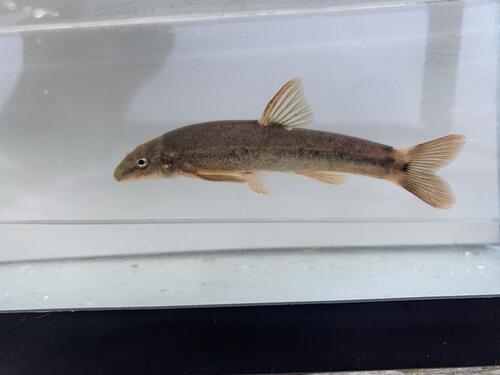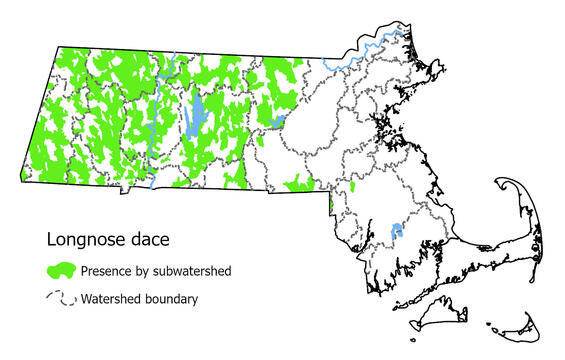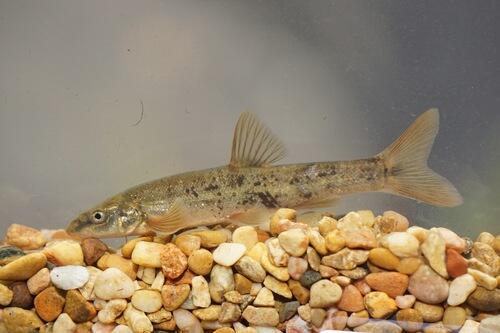- Scientific name: Rhinichthys cataractae
- Species of Greatest Conservation Need (MA State Wildlife Action Plan)
Description

Longnose dace (Rhinichthys cataractae)
The longnose dace has an elongated fusiform body shape with very small scales giving it a smooth feel. This species has a barbel at each corner of the small subterminal mouth, and a band of tissue (frenum) connects the upper lip to the snout. Longnose dace can vary from dark to light olive, brownish, or tan on the dorsal and lateral side and pearly white on the ventral. Mottling is often present. Breeding males develop tubercles on their head and fins and an orange-red coloration at the base of the pectoral and pelvic fins, on the cheek, throat, and lips; an orange wash is sometimes present along the lateral line and on the dorsal and anal fins as well. Adults are normally about 3 inches but sometimes can reach 6 inches or more. They can live up to 4 or 5 years.
The longnose dace is most similar to the blacknose dace but can be distinguished by the relative length of the snout (longer than the blacknose dace), subterminal mouth, the eye size, the position of the eye in relation to the mouth, and the lack of a prominent lateral stripe – although this stripe can sometimes be present in juveniles. Longnose dace can also sometimes be mistaken for suckers, but they lack the papillae found on the mouths of suckers.
Life cycle and behavior

Longnose dace’s diet consists primarily of aquatic invertebrates, such as larvae of blackflies and midges.
Longnose dace spawn from late spring through summer (~May-August), sometimes multiple times. Female dace deposit their eggs, which are then fertilized by the male, into small depressions or clearings in the substrate of shallow gravel riffles. These clearings are made and defended by the males. There is no parental care.
Distribution and abundance
In western Massachusetts, the species is common in clear streams with riffles, boulders, and gravel, but they have also been sampled in large numbers from larger, lower-gradient mainstem rivers. The species is absent from almost all of the eastern part of the state except in upland tributaries to the Nashua River.

Data from 1999-2024 from annual surveys.
Habitat
Longnose dace are usually associated with steep-gradient, cold-water streams, but they are also sometimes found in lower-gradient, warm-water rivers. They seem to spend most of their adult lives on or near the bottom in turbulent water or adjacent pools.
Healthy habitats are vital for supporting native wildlife and plants. Explore habitats and learn about conservation and restoration in Massachusetts.
Threats
Water pollution, warming water temperatures, habitat fragmentation, stream flow alteration, and sediment deposition in spawning areas are threats to this species. Climate change is likely to impact this coolwater species as temperatures in rivers continue to warm and flood and drought extremes increase.
Conservation

Longnose dace (Rhinichthys cataractae)
Not enough is known about longnose dace in Massachusetts waters to develop a species-specific management plan. While they are common in suitable cool and coldwater habitat throughout the state, the impact of the threats listed above is so extensive that the distribution and abundance of this species is limited and lacks resilience to large scale disturbance. It is anticipated that conservation and management initiatives targeting keystone species, such as brook trout, or broader ecosystem-based management objectives would also be indirectly beneficial to longnose dace.
References
Karsten E. Hartel, David B. Halliwell, and Alan E. Launer. Inland Fishes of Massachusetts. Lincoln, Massachusetts: Massachusetts Audubon Society, 2002
Contact
| Date published: | April 11, 2025 |
|---|